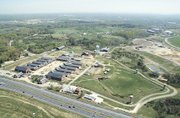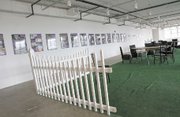When the overcrowded and run-down Lorton Reformatory closed in 2002, the debate began in the community about what to do with the land the prison complex sat on.
The facilities at 9601 Ox Road in Lorton were already steeped in history. Originally established by Congress at the behest of President Theodore Roosevelt in 1910, the Occoquan Workhouse in Lorton was designed to use its own prisoners to work the land. Over the decades, it became famous as the site where 123 members of the National Women’s Party housed and mistreated after picketing Woodrow Wilson’s White House in 1917, as well as a housing site for Nike anti-aircraft missiles during the Cold War.
In recent years, the prison’s historical significance took a backseat to its reputation as a community eyesore. With the week-long grand opening of the Workhouse Arts Center on Sept. 19, 2008, the Lorton Arts Foundation seeks not only to transform that reputation with a massive, multi-faceted renovation of the facility, it hopes to put Lorton on the map as one of the preeminent institutions of artistic expression in the Washington, D.C. area.
"This is a world-class arts center in your backyard," said Tina Leone, CEO of the Lorton Arts Foundation.
THE EFFORTS and resources required to make that world-class center a reality were daunting. The prison complex is nearly 100 years old. The various utility lines including sewer, water and electricity all had to be replaced, as well as large-scale construction and renovation efforts on the buildings themselves. The Workhouse, currently in what is being called "Phase one," consists of 10 buildings, mostly former prisoner dormitories, revamped into art studios, galleries, workshops and exhibitions. Classes in subjects like acting, dancing, ceramics, painting, photography and sculpting will be offered to the public and studio space will be leased out to area artists.
"There is nothing like this in the United States," said Leone. "We’ve looked."
The goal of the center is two-fold: create a regional hub that will act as a magnet both for established artists to display their work and amateur students looking to hone their craft.
The foundation also has plans to operate the center as a venue for festivals, events, performances and exhibitions. "Phase two" of the Workhouse Arts Center, planned for construction in 2009, will add a 300-seat performance theater, a music barn and 40 live-in studio apartments leased out to artists who will live, work and display their art on-site. Plans are also in the works to create a museum
EACH ARTIST at the Workhouse, according to Leone, has submitted their work to be reviewed by a panel of critics selected by the foundation before they become contributing members of the Workhouse Artist Association.
Alex Beard demonstrated the versatility of the center when discussing his involvement during the opening festivities. A drawing artist and oil painter by trade, Beard will be displaying his work in the main exhibition hall, as well as conducting several workshops with children. The desire by the Lorton Arts Foundation to make the Workhouse Arts Center equally accessible to the public as well as the artist appealed to him.
"It will be one of the few places, maybe unique in this respect, where it will be able to bridge the arch between arts and crafts, the artists and the public," said Beard, who owns studio galleries in Soho, N.Y. and New Orleans, La. "The fine artiste and the true craftsman are ultimately doing the same thing."
Those points were echoed by Leone.
"We will not only bring the best of the art world to Lorton, but also remain community-oriented and provide these opportunities to everyone," she said.
One local group anticipating the September opening of the Workhouse is the Springfield Art Guild. The SAG has been invited to be the first group to show in the center's main gallery space.
"The members of the Springfield Art Guild were instrumental in supporting the Lorton Arts Foundation’s efforts to open the workhouse," said Sharon Mason, executive arts director for the Lorton Arts Foundation. "They have helped for five years with things like feasibility studies leading up to the county’s signing of the lease. We chose the Springfield Arts Guild to be one of the first to exhibit because of the effort they made to get us to where we are."
Like the Springfield Arts Guild, many art groups around Fairfax County have no galleries, according to Mason. The Lorton Workhouse Arts Center will feature art from these groups regularly.
TO AVOID depending on county funding to prop the center up financially, Leone said she was hired in 2002 to devise a business plan that would make the Workhouse a self-sustaining entity. The center has already leased out all available studio space to local artists two months before September. Plans are underway to build a performing arts center where accredited courses will be offered.
The Lorton Arts Foundation has also raised over $4.7 million in the last two years through various fund-raisers, including a performance by Mikhail Baryshnikov in September last year that brought in $1.4 million.
A small army of around 80 volunteers will provide support to the 35 full-time employees expected to be on the center’s payroll by September.
Beard said that overall he enjoyed the symbolism the center displayed in contemporary American life.
"One of the ideas I love about the Workhouse is the idea of converting a prison into an arts center," he said. "Mostly, as you go around rest of the country, the exact opposite is happening. The arts are being cut and more prisons are being built. It’s much healthier for our larger culture and our society to have more arts and less prisons."


